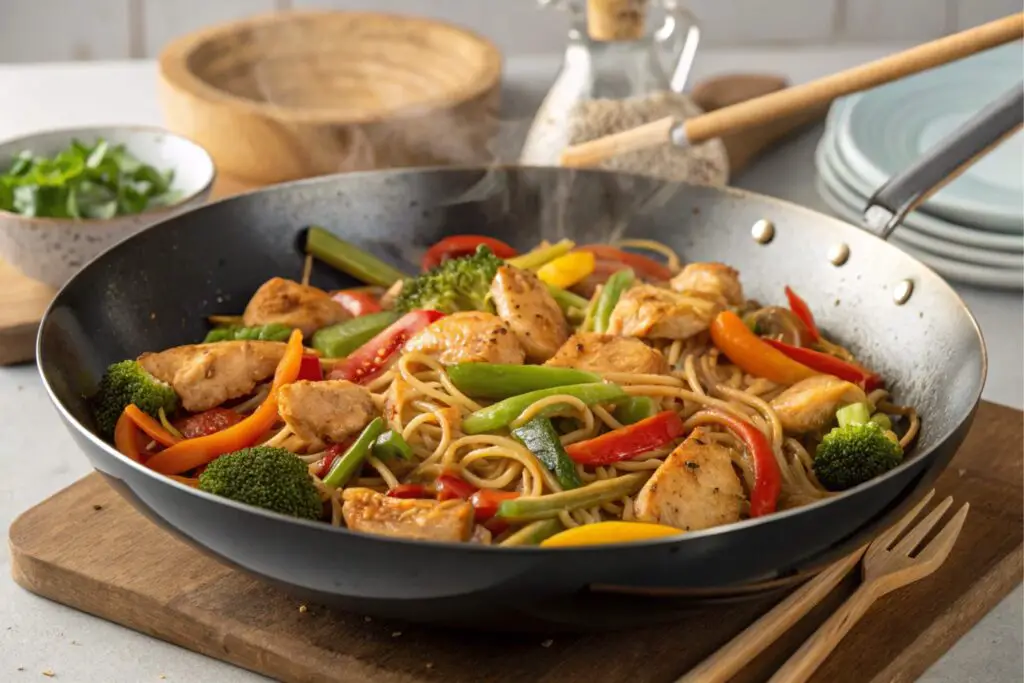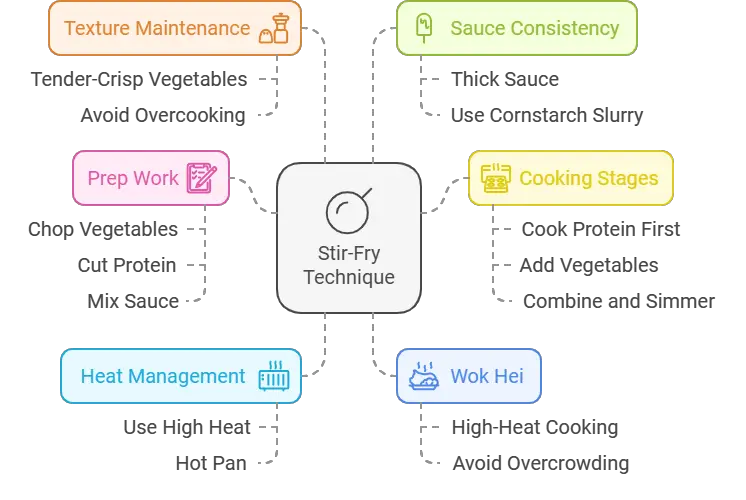want to listen to the recipe ?

Have you ever wondered how to get a delicious, healthy meal on the table in just minutes? Stir-fries are my go-to solution for those busy weeknights. They’re incredibly versatile, budget-friendly, and packed with flavor. In this post, I’ll show you how to make the perfect chicken stir-fry at home, with all my tips, techniques, and variations. Get ready to transform your dinner routine!
Why Stir-Fry?
- Speed and Convenience: Stir-fries are incredibly fast to cook, usually taking about 20-30 minutes from start to finish. This is perfect when you don’t have much time but still want a nutritious meal.
- Versatility and Customization: You can use almost any combination of protein and vegetables in a stir-fry. This makes it easy to use what you have on hand.
- Budget-Friendly Meal: Stir-fries are great for saving money. Use seasonal produce and shop for sales. Pantry staples make it even more affordable.
- Health Benefits: A stir-fry can be a very healthy meal. It includes lean protein and lots of vegetables. You can easily adjust it to fit your dietary needs.
- Meal Prep Potential: Stir-fries are great for meal prep. They store well in the fridge and can be easily reheated for lunch or another dinner.
Essential Ingredients for Chicken Stir-Fry
Protein
- Chicken: Boneless, skinless chicken breasts are my preferred choice. You can also use chicken thighs, which are usually more affordable. Cut the chicken into small, even pieces so it cooks quickly.
- Alternatives: You can easily use beef, shrimp, tofu, or other plant-based proteins instead of chicken.
Vegetables
- Core Vegetables: I often use broccoli, carrots, bell peppers, and onions. These vegetables cook well in a stir-fry and add great flavor and color.
- Other Options: Don’t hesitate to mix in snow peas, mushrooms, sliced cabbage, kale, water chestnuts, or bamboo shoots. Use whatever you have on hand.
- Fresh or Frozen: Fresh vegetables are best, but frozen veggies work too. Add frozen vegetables towards the end of the cooking time so they don’t get mushy.
- Pre-Mixed: You can also buy pre-mixed bags of stir-fry vegetables. This saves time and effort.
Aromatics
- Garlic & Ginger: Fresh garlic and ginger are essential for flavor. Mince or grate them finely before adding to the stir-fry.
- Optional Additions: Shallots or green onions can also add flavor.
Stir-Fry Sauce Basics
- Soy Sauce: Soy sauce is a must-have for stir-fries. I recommend using low-sodium soy sauce.
- Sweetener: Use brown sugar or honey for sweetness. Adjust the amount to your taste.
- Oil: Toasted sesame oil adds a great flavor. Use a neutral oil like vegetable or canola for cooking.
- Thickener: Cornstarch helps thicken the sauce.
- Liquids: Water or chicken broth thins the sauce and adds flavor.
- Spice: Add sriracha or crushed red pepper flakes for a spicy kick.
Optional Garnishes
- Toppings: I like to top my stir-fry with sesame seeds and sliced green onions. You can also use fresh coriander.
- Serving Suggestions: Serve with rice, noodles, or your favorite side dish.
[woo_product_slider id=”3030″]
Mastering the Stir-Fry Technique

- Prep Work is Key: Before you start cooking, prepare all your ingredients. Chop your vegetables, cut your protein, and mix the sauce.
- Heat Management: Use high heat for stir-frying. A wok or large skillet works best. Ensure the pan is hot before adding any ingredients.
- Cooking in Stages:
- Cook the Protein First: Start with the chicken. Cook until browned and cooked through. Remove it from the pan and set it aside.
- Cook the Vegetables: Add the vegetables based on how long they take to cook. Start with harder vegetables like carrots and broccoli.
- Combine and Simmer: Add the chicken back to the pan. Pour the stir-fry sauce over everything and stir to combine. Let the sauce simmer until it thickens.
- Achieving “Wok Hei”: “Wok Hei” is the slightly smoky flavor you get from high-heat cooking. To get this flavor at home, make sure your pan is very hot and don’t overcrowd it.
- Maintain Texture: I prefer my vegetables to be tender-crisp, not mushy. Avoid overcooking them.
- Sauce Consistency: The sauce should be thick enough to coat the chicken and vegetables. If the sauce is too thin, you can simmer it longer or add a little cornstarch slurry.
Flavor Variations and Customization
- Savory Sauce Options: If you want less sweetness, use less brown sugar or honey. You can also try adding oyster sauce or mushroom soy sauce for a deeper flavor.
- Spicy Sauce Options: Use different types of chili peppers or sauces to control the spice level. You can add chili oil, chili garlic sauce, or different chili flakes.
- Global Inspirations:
- Thai Stir-Fry: Try fish sauce, Thai basil, and coconut milk for a Thai-inspired stir-fry.
- Korean Stir-Fry: Use gochujang, sesame oil, and kimchi for a Korean flavor.
- Japanese Stir-Fry: Yakisoba noodles are a great base for a Japanese style stir-fry.
- Marinating: Marinating your chicken before stir-frying will add more flavor.
- Acidic Components: Adding rice vinegar or lemon juice balances the flavors in a stir fry.
Dietary Considerations and Adaptations
- Low-Carb and Keto: Use low-carb vegetables, proteins, and sugar-free sauces for keto stir-fries.
- Vegetarian and Vegan: Use tofu or tempeh instead of chicken. Make sure your sauce is vegan-friendly.
- Gluten-Free: Use gluten-free soy sauce (tamari or coconut aminos) and gluten-free noodles.
Ingredient Sourcing and Sustainability
- Locally Sourced Ingredients: Buy local and seasonal vegetables whenever you can. Check out your local farmers’ markets.
- Sustainable Seafood: Choose sustainably sourced seafood.
- Reducing Food Waste: Use vegetable scraps to make vegetable broth.
Common Mistakes
- Overcrowding the Pan: Don’t overcrowd the pan, as this will cause the ingredients to steam instead of stir-fry. Cook in batches if necessary.
- Overcooking Vegetables: Don’t overcook the vegetables. They should still have a bit of a crunch.
- Adding Too Much Sauce: Avoid adding too much sauce which can result in a soggy stir-fry.
- Sauce Too Runny: If your sauce is too runny, let it simmer a little longer. You can also add a cornstarch slurry to thicken it.
Serving and Meal Prep Ideas
- Serving Suggestions: Serve your stir-fry with brown rice, white rice, or coconut rice. You can also use noodles or even quinoa.
- Garnishing: I like to top my stir-fry with green onions and sesame seeds for added flavor.
- Meal Prep Instructions: Let your stir-fry cool completely before storing in meal prep containers. You can store it in the fridge for about four days. Reheat it on the stove or in the microwave.
Conclusion
Chicken stir-fries are truly one of my favorite meals. They’re quick, easy, and customizable. I encourage you to experiment with different flavors and ingredients to create your own perfect stir-fry. Now it’s your turn – share your favorite stir-fry creations in the comments below!


